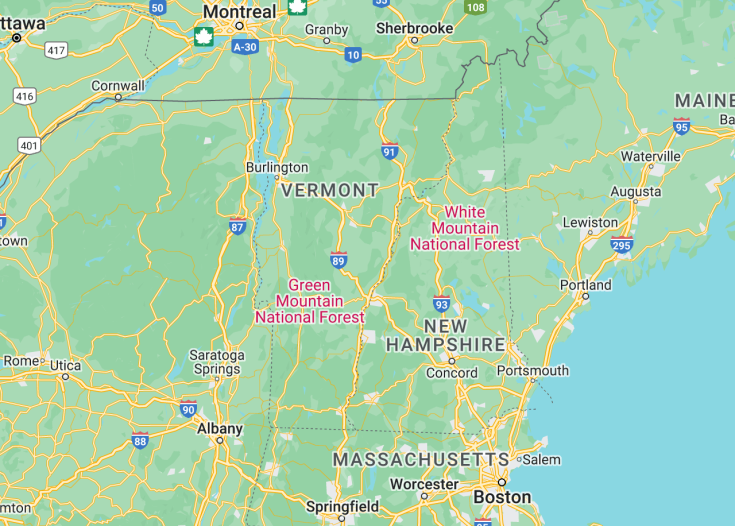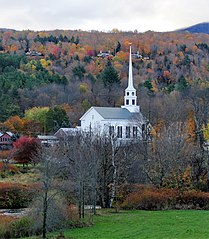With its tapestry of verdant forests, picturesque towns, and rolling hills, Vermont stands as New England’s serene jewel. In autumn, the state transforms into a spectacle of fiery reds and oranges, while winter brings pristine snows perfect for skiing. Whether it’s the artisanal charm of Burlington, the rich history of Montpelier, or the peaceful allure of Lake Champlain, Vermont offers a timeless retreat from the frenetic pace of modern life. Experience craft breweries, maple syrup farms, and a deeply rooted farm-to-table culture in this state of understated beauty.
For peak fall foliage, aim to visit in early to mid-October. The colors are unforgettable.
Explore the state’s numerous farmers’ markets to taste the freshest produce and local specialties.
Top destinations in Vermont (USA)
Vermont: The Green Mountain State
| Capital | Montpelier |
| Time in Vermont | GMT-4 |
| Language spoken | English |
| Population | 626,299 (source: World Population Review) |
| Religion | Christianity (63.1%), No Religion (32.6%), Other Religions (4.3%) |
| Currency | United States Dollar (USD) |
| Airports | Burlington International Airport Rutland – Southern Vermont Regional Airport Lebanon Municipal Airport |
Nestled in the northeastern part of the United States, Vermont is an enchanting blend of green mountains, deep-blue lakes, and lush valleys. Often referred to as the “Green Mountain State,” due to its verdant landscapes, Vermont’s history is steeped in the tales of Indigenous tribes, revolutionary battles, and the growth of American democracy. From the Abenaki peoples who first called this land home to its pivotal role in the American Revolutionary War, Vermont has played an integral part in shaping the nation’s history.
The state was an independent republic before it joined the Union as the 14th state. Over time, it has retained its character as a haven for artisans, thinkers, and nature lovers. Tourists visiting Vermont are drawn not only to its historical sites but also to its natural beauty that manifests in every season. Whether it’s the fiery hues of fall foliage, the pristine white of winter snow, the blossoming spring, or the sun-drenched summer, Vermont offers picturesque views year-round.
Additionally, Vermont is a hub for skiing, hiking, and other outdoor activities, attracting adventurers from around the globe. Its artisanal cheeses, maple syrup, and craft beers are just a few examples of its rich culinary heritage. From its quaint towns to the bustling city of Burlington, Vermont consistently offers an inviting and memorable experience for all who visit.
Where is Vermont located?
Vermont is located in the northeastern region of the United States, bordered by New Hampshire to the east, New York to the west, Massachusetts to the south, and the Canadian province of Quebec to the north.
What is Vermont famous for?
Vermont is celebrated for its scenic Green Mountains, rich history, vibrant fall foliage, artisanal cheeses, pure maple syrup, and as a premier destination for skiing and outdoor recreation.
History
Prehistoric Era: First Inhabitants
Long before European settlers arrived, Vermont was inhabited by indigenous tribes, primarily the Western Abenaki and the Mohican. These tribes engaged in fishing, hunting, and agriculture, and left behind numerous artifacts that provide insights into their way of life, including pottery, tools, and burial sites.
1609: European Exploration
The first known European to lay eyes on the region that is now Vermont was the French explorer Samuel de Champlain. In 1609, he journeyed down the lake that would later bear his name, Lake Champlain, establishing the area as a region of interest for the French.
18th Century: Colonial Disputes and Settlement
Throughout the early 1700s, Vermont became a disputed territory between the French and British empires, and later between New York and New Hampshire. Both New York and New Hampshire granted land in the region, leading to conflicting claims. The Green Mountain Boys, a militia led by Ethan Allen, played a significant role in defending the New Hampshire land grants against the New Yorkers.
1777: The Vermont Republic
Amidst the tumult of the Revolutionary War, Vermont declared itself an independent republic in 1777, complete with its constitution—remarkably, the first written constitution in North America to ban adult slavery. The Vermont Republic operated independently for 14 years, even coining its currency.
1791: Statehood
Vermont’s aspirations went beyond being an independent republic. In 1791, it became the 14th state to join the Union, the first state after the original thirteen colonies. This addition signified the beginning of westward expansion and set a precedent for the inclusion of other states.
19th Century: Agriculture, Industry, and Abolition
Throughout the 1800s, Vermont experienced growth in both agriculture, particularly dairy farming, and industry, with the establishment of mills and factories. Simultaneously, Vermonters were vocal advocates for the abolition of slavery. The state played a crucial role in the Underground Railroad, with many Vermonters assisting escaped slaves on their journey to freedom in Canada.
20th Century: Economic Challenges and Modernization
The early 1900s brought economic challenges to Vermont, as the Great Depression hit its agricultural sector hard. However, the mid-20th century saw a shift towards tourism, with the development of ski resorts and the promotion of Vermont’s idyllic landscapes and autumn foliage. This period also marked advancements in infrastructure, including the establishment of the Interstate Highway System in the state.
21st Century: Contemporary Vermont
Today, Vermont stands as a beacon of progressivism and environmental consciousness. The state has been a pioneer in promoting sustainable practices, from organic farming to green energy solutions. Its cultural landscape is enriched by a mix of traditional New England values and a forward-thinking approach to societal challenges. Vermont’s commitment to preserving its natural beauty and fostering a tight-knit community makes it a unique and cherished part of the American fabric.
Visit Vermont
What to see and do in Vermont
When visiting Vermont, there are several attractions and activities worth exploring. Some of the must-see destinations include:
- The Green Mountains: A scenic mountain range perfect for hiking, skiing, and enjoying breathtaking views.
- Lake Champlain: A large freshwater lake offering opportunities for boating, fishing, and water sports.
- Burlington: A vibrant city with a waterfront area, eclectic shops, and a lively arts scene.
- Ben & Jerry’s Ice Cream Factory: Take a tour of the famous ice cream company and indulge in delicious treats.
- Stowe: A charming town known for its ski resorts, luxury spas, and historic buildings.
Visitors to Vermont can also enjoy outdoor activities such as leaf peeping during the vibrant fall foliage season, exploring the quaint villages and covered bridges, and indulging in local cuisine, including maple syrup and Vermont cheddar cheese.
Events and Festivals in Vermont
Vermont hosts a variety of events and festivals throughout the year. Here are some notable ones:
- Maple Open House Weekend (March): Celebrate Vermont’s maple syrup industry with tours of sugarhouses and tastings.
- Strolling of the Heifers Parade (June): A unique parade featuring cows and local farmers, promoting sustainable agriculture.
- Vermont Brewers Festival (July): A gathering of craft breweries from Vermont and beyond, offering tastings and live music.
- Brattleboro Winter Carnival (February): Enjoy winter sports, ice carving, and a polar bear plunge during this festive event.
- Champlain Valley Fair (August-September): Vermont’s largest annual fair featuring agricultural exhibits, live performances, and carnival rides.
These events showcase the culture, traditions, and local pride of Vermont, making them a great way to experience the state’s unique charm.
Best time to visit Vermont
The best time to visit Vermont depends on personal preferences and the desired activities. The state experiences four distinct seasons, each offering its own appeal. Here are some recommendations:
Spring (April to June): This season brings blooming flowers, milder temperatures, and the opportunity to witness maple syrup production.
Summer (July to August): Ideal for outdoor activities like hiking, boating, and attending festivals.
Fall (September to October): Renowned for its stunning fall foliage, this is the peak tourist season in Vermont.
Winter (December to February): Perfect for skiing, snowboarding, and enjoying the picturesque snowy landscapes.
It’s important to note that weather conditions can vary, and it’s advisable to check for any specific events or activities of interest before planning a trip.
Is Vermont worth visiting?
Vermont, with its picturesque landscapes, charming small towns, and vibrant cultural scene, is certainly worth visiting. The state’s natural beauty, particularly during the fall foliage season, is a major draw for tourists. Vermont’s commitment to conservation and sustainable practices also makes it an attractive destination for those seeking an eco-friendly getaway.
However, it’s worth considering that Vermont’s rural character may not appeal to everyone. The state’s slower pace of life and lack of major cities might disappoint visitors looking for a more bustling urban experience. Additionally, the winter weather and remote location can present challenges for some travelers.
Ultimately, whether Vermont is worth visiting depends on individual interests and preferences. For those who appreciate outdoor activities, scenic landscapes, and a laid-back atmosphere, Vermont offers a unique and memorable vacation experience.












